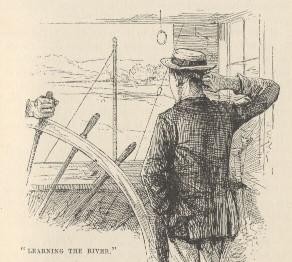Steamboat: PENNSYLVANIA
• Built: 1854
• Tonnage: 486
• Clemens' Service: 27 September - 26 November 1857
• and 17 February - 5 June 1858
• Pilot: William Brown
• Co-Pilot: George Ealer
• 1st Mate: Abner Martin
• Captain: John Klinefelter
• Fate: 13 June 1858 lost by explosion
November 2 Monday – Sam was now under the infamous William Brown, co-pilot George Ealer (1829-1866) on the steamboat Pennsylvania (486 tons). The ship left this date for New Orleans. In Chapters 18-19 of Life on the Mississippi, Sam recounted the conflict with Brown: “…a middle-aged, long, slim, bony, smooth-shaven, horse-faced, ignorant, stingy, malicious, snarling, fault-hunting, mote-magnifying tyrant.” From their first meeting, nothing Sam did was right for Brown. Cub Sam would lie in his bunk at night thinking of creative ways to kill Brown. Imagination was all that was left to Sam, since it was a “penitentiary offense” to strike a steamboat pilot. The other cub on board was George Ritchie, who was blessed with serving watch only for the co-pilot George Ealer, as amiable as Brown was nasty. Whenever Sam took the wheel for Ealer’s watch, Ritchie would mimic Brown, which got old fast with Sam. The conflict between Brown and Sam would peak the next June [Schmidt].
November 8 Sunday – Pennsylvania arrived in New Orleans.
November 10 Tuesday – Pennsylvania left for St. Louis. With Brown gone, George Ealer was most likely the pilot.
November 16 Monday – Pennsylvania arrived in St. Louis.
November 18 Wednesday – Pennsylvania left for New Orleans.
November 24 Tuesday – Pennsylvania arrived in New Orleans.
November 26 Thursday – Pennsylvania left for St. Louis. About thirty miles above New Orleans it was struck by the Vicksburg and lost its wheelhouse. The boat was laid up for repairs near New Orleans for eleven weeks. Some accounts say the two boats were racing, an illegal but common activity for steamboats. On Mar. 19, 1858, Sam would give testimony for a lawsuit in the matter. His remarks include observations of the boat: I was on the PENNSYLVANIA as Steersman at the time of the collision in November last. I was not at the wheel at the time. At the moment of the collision I was standing on the Sky light deck, aft of the Pilot house…..I think that at the instant the VICKSBURG struck us that one of her engines was still going—and my reason for thinking so is, that she did not recede from us after she struck, but kept pressing on—the crash of timbers continued—the deck swayed under me, and I thought I heard the noise of her engines. It was over a minute after the VICKSBURG struck us, before she began to back away from us. After the boats came together, I heard the Captain of the VICKSBURG call to Captain Klinefelter, and I understood him to say that he (Capt White) “Knew that the VICKSBURG would run from the bar.” I am learning the river—have been learning it, now, about ten months. At that time I had been on the PENNSYLVANIA about three trips. The PENNSYLVANIA steers very easily, I was in the Pilot house that night before supper, and I noticed that she steered well—that is her general character for steering. The PENNSYLVANIA is a first class boat every way—she is large, and well finished for a passenger boat. The officers and crew which the PENNSYLVANIA had at the time of the collision were all of them capable sober and patient. When I was on the extreme stern of the PENNSYLVANIA as above stated, Capt Klinefelter was there—I do not know where he was after that. After the collision the VICKSBURG towed the PENNSYLVANIA to the right hand shore. The VICKSBURG then backed off. I am not exactly certain whether I was in a position to see her when she left us. I do not think she landed after she left us—I think she just backed out, ad went up the river. I am certain she did. John Klinefelter et. al. vs. Steamer Vicksburg, J. M. White, Master, National Archives [Marleau, “Eyewitness” 18-19].
